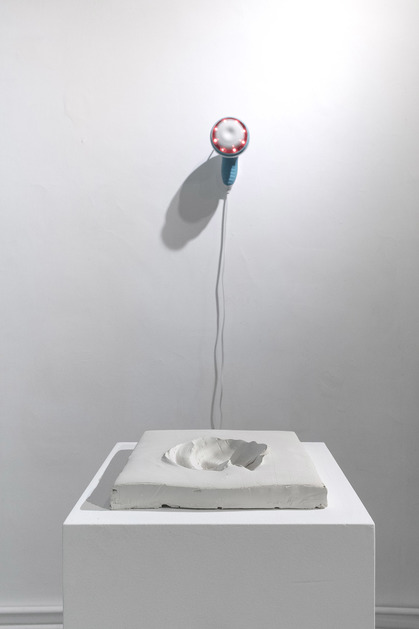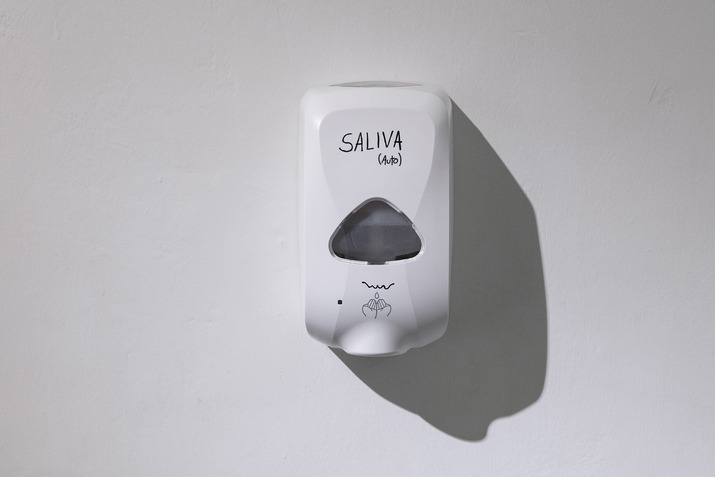-
From Current Issue
-
- Editor’s Letter Fire in the Heart
- Reviews I Gusti Ayu Kadek Murniasih
- Reviews 11th Seoul Mediacity Biennale: “One Escape at a Time”
- Dispatch Networked China
- One on One Monira Al Qadiri on Yukio Mishima
- Essays The rise of independent art spaces in pandemic-era Shanghai
- Features Tuan Andrew Nguyen
- Table of Contents
- Web Exclusives
- Archive
- Subscribe

R
E
V N
E
X
T
Installation view of CHRIS SHEN’s “Cold Hands, Warm Heart” at Bedroom, Hong Kong, 2019. All photos courtesy the artist and Bedroom, Hong Kong.
At the entrance of Bedroom, a multidisciplinary space located on the top floor of an industrial building in Kowloon, was an instruction. Affixed to the white door was a nondescript metal sign imprinted with the command “PULL” above an elongated bar handle. Yet visitors found that the door could only be opened with a push.
Masquerading as commonplace signage, Give and Take was one of the nine works (all works 2019) that made up Chris Shen’s solo exhibition at Bedroom. By asking visitors to perform an action contradictory to the one required to enter the space, Shen suggests that physical connection can be an antidote to perceived ideological conflicts. This notion was also embodied in the exhibition’s title, “Cold Hands, Warm Heart,” which appropriates a popular adage describing a person who appears aloof externally but defies preconceptions to be unexpectedly cordial.
Installation view of CHRIS SHEN’s Touch, 2019, digital print on tracing paper, 42 × 59.4 cm, at “Cold Hands, Warm Heart,” Bedroom, Hong Kong, 2019.
The possibilities of physical contact were further investigated in other pieces such as Touch. Printed onto tracing paper, the work lists exemplary sentences from online dictionaries expounding on the multiple connotations associated with the word “touch.” With these constructed scenarios, evoked through text, Shen evinces the mutability of the word’s various meanings, and explores its role across diverse social settings and in interpersonal relationships.
While Shen identifies physical contact as intrinsic to human expression, they also examine how this relationship has changed in the digital age. Four clay sculptures, each molded by the motorized motions of different massage devices, reflect on how technology can emulate tangible experiences once thought to be limited to humans. However, Shen also recognizes that technology is fallible. Unsolicited physical intimacy resulting from failed automation is spotlighted in Contact, Less, a video compilation of surveillance-camera footage capturing people walking into entryway barriers of buildings. Although some clips seem to highlight human folly rather than robotic malfunction, Shen effectively demonstrates the caveats of relying on technology in these performances of automated inconveniences.
Shen also tests humankind’s confidence in publicly disseminated information with Saliva (Auto): an automatic dispenser mounted onto a wall, recalling similar types found in public spaces. The work’s title is handwritten on the apparatus’s exterior as, one can presume, a disclaimer about its contents. Thoroughly piqued and skeptical about this declaration, I lay my hands beneath the sensor which activated the dispenser to eject a clear viscous gel bearing the scent of alcohol sanitizer. Immediately after this occurred, a panicked gallery staff member exclaimed at me to wash my hands. Apparently, Shen had indeed included their own saliva within the mix based on the widespread cultural belief in the healing and antibacterial properties of the bodily fluid. Unless scientifically confirmed, however, the extent of these claims remain uncertain. With this work, Shen insinuates that we should re-evaluate our choices to trust in and respond to such “facts.”
The last work in the show, Tears in Rain, is an assemblage described by the artist as “a sad work about the motions of time.” A transparent tank of water is connected to a rain shower head, which drips intermittently onto the heated surface of a halogen lamp. Shen’s setup refers to the Second Law of Thermodynamics, which theorizes that entropy is invariably decreasing because energy will always flow from hot to cold. This one-directional equation is commonly extended to the concept of time in scientific writing, and by alluding to this, Shen tendered an existential commentary on bleak climate prospects and the unfortunate truth of how all present moments are held hostage to time.
Admittedly, Tears in Rain felt tangentially detached from the rest of the exhibition’s narrative, which was mostly centered around an inquiry into the physical relationships we share with certain inanimate objects and our trust in them. Despite this disconnect, Shen’s works and their messages are warranted in an epoch where technological species increasingly inhabit both our public and private domains. Ultimately, the success of “Cold Hands, Warm Heart” lay in its ability to provoke essential questions about mutual coexistence.
Evelyn Goh is an editorial intern of ArtAsiaPacific.
“Cold Hands, Warm Heart” is on view at Bedroom, Hong Kong, until September 21, 2019.
To read more of ArtAsiaPacific’s articles, visit our Digital Library.




















